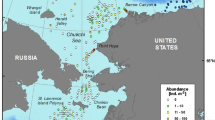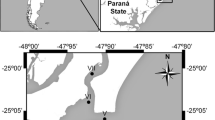Abstract
Environmental factors determining the spatial pattern of the whole siphonophore community, as well as the hydrological occurrence ranges, small-scale vertical distribution, and spatial niche breadth and overlap of 23 siphonophore species collected off a riverine system in the southern Gulf of Mexico were analysed. A total of 149 zooplankton samples were collected in different strata of the water column (from 0 to 100 m) over a grid of 23 oceanographic stations during low (April) and high (October) rainy periods. Temperature and salinity measurements were taken with a CTD probe. Considering both seasons, salinity fluctuated between 30.7 and 37.0, and temperature between 18.2 and 29.0°C. Under these conditions, the hydrological occurrence ranges of species were analysed. Data on siphonophore biovolumes in the upper 30-m layer were subjected to a regression tree (RT) analysis taking the zooplankton biomass, the distance to the shore, the temperature, and the salinity as predictable variables. Results of the RT analysis showed that the distance from the shore, food availability, and temperature were among the most important factors affecting siphonophore spatial distribution. Food availability had a positive influence on the siphonophores distribution, whereas temperatures higher than 28.1°C seemed to depress most siphonophore populations. Diphyes dispar moderately dominated the community and represented 30% of the total biovolume. The calycophorans Abylopsis tetragona, A. eschscholtzi, Diphyes bojani, and Chelophyes appendiculata were the most generalist species as revealed by their niche breadth values, and Enneagonum hyalinum endured the widest salinity conditions (30.7–37.0) and was mainly distributed in coastal waters. The second most abundant species, the physonect Agalma okeni, exhibited a low mean niche overlap value with the calycophoran species. We hypothesise that differences in diet composition between physonects and calycophorans are the main cause of those low niche overlap values.






Similar content being viewed by others
References
Alba-Hurtado C (2001) Composición, abundancia y distribución de los sifonóforos (Cnidaria: Hydrozoa), en la Bahía de Campeche, México. Bch. Thesis FES Zaragoza, Universidad Nacional Autónoma de México
Alcaraz M, Saiz E, Calbet E, Trepat I, Broglio E (2003) Estimating zooplankton biomass through image analysis. Mar Biol 143:307–315
Alvariño A (1968) Los quetognatos, sifonóforos y medusas en la región del Atlántico ecuatorial bajo la influencia del Amazonas. An Inst Biol Univ Nal Autón Méx 39, Ser Cienc del Mar y Limnol 1:41–76
Alvariño A (1971) Siphonophores of the Pacific, with a review of the world distribution. Bull Scripps Inst Oceanogr Univ Calif 16:1–432
Alvariño A (1981) Siphonophora. In: Boltovskoy D (ed), Atlas de zooplancton del Atlántico Sudoccidental y métodos de trabajo con el zooplancton marino. INIDEP, Mar de Plata, pp 383–442
Alvariño A (1985) Predation in the plankton realm, mainly with reference to fish larvae. Invest Mar CICIMAR 2:1–122
Biggs D (1976) Nutritional ecology of Agalma okeni and other siphonophores from the epipelagic Western North Atlantic. PhD Thesis, WHOI-MIT joint program, 141 pp
Boucher J, Thiriot A (1972) Zooplancton et micronecton estivaux des deux cents premiers mètres en Méditerranée Occidentale. Mar Biol 15:47–56
Brooks DR, McLennan DA (1994) Historical ecology a research programme: scope, limitations and the future. In: Eggleton P, Vane-Wrigth RI (eds) Phylogenetics and ecology. Linnean Society Symposium Series 17. Academic Press, London, pp 1–27
Colwell RK, Futuyma DJ (1971) On the measurement of niche breadth and overlap. Ecology 52:567–576
Czitrom SPR, Ruiz F, Alatorre MA, Padilla AR (1986) Preliminary study of a front in the Bay of Campeche, Mexico. In: Nihoul JCJ (eds) Marine interfaces ecohydrodynamics. Elsevier Oceanography Series, Liege, pp 301–311
den Hartog JC (1980) Notes on the food of sea turtles: Eretmochelys imbricata (Linnaeus) and Dermochelys coriacea (Linnaeus). Neth J Zool 30:595–610
Dunn CW, Pugh PR, Haddock SHD (2005) Molecular phylogenetics of the Siphonophora (Cnidaria), with implications for the evolution of functional specialization. Syst Biol 54:916–935
Flores-Coto C, Sanvicente-Añorve L, Pineda-López R, Rodríguez Van Lier MA (1988) Composición, distribución y abundancia ictioplanctónica del sur del Golfo de México. Universidad y Ciencia 5:65–84
Gasca R (1993) Especies y abundancia de sifonóforos (Cnidaria: Hydrozoa) en la región sur del Golfo de México. Caribb J Sci 29:220–225
Gasca R (1999) Siphonophores (Cnidaria) and the summer mesoscale features in the Gulf of Mexico. Bull Mar Sci 65:75–89
Gibbons MJ, Thibault-Botha D (2002) The match between ocean circulation and zoogeography of epipelagic siphonophores around southern Africa. J Mar Biol Assoc UK 82:801–810
Gili JM, Pagès F, Sabatés A, Ros JD (1988) Small-scale distribution of a cnidarian population in the western Mediterranean. J Plankton Res 10:385–401
Grice GD, Hart AD (1962) The abundance, seasonal occurrence and distribution of the epipelagic zooplankton between New York and Bermuda. Ecol Monogr 32:287–309
Kaspari M (2005) Global energy gradients and size in colonial organisms: worker mass and worker number in ant colonies. Proc Natl Acad Sci USA 102:5079–5083. doi:10.1073/pnas.0407827102
Lane P (1975) The dynamics of aquatic systems: a comparative study of the structure of four zooplankton communities. Ecol Monogr 45:307–336
Lauerman LML (1998) Diet and feeding behaviour of the deep-water sea star Rathbunaster californicus (Fisher) in the Monterey Submarine Canyon. Bull Mar Sci 63:523–530
Levins R (1968) Evolution in changing environments. Princeton University Press, Princeton
Lewis JB, Fish AG (1969) Seasonal variation of the zooplankton fauna of surface waters entering the Caribbean Sea at Barbados. Caribb J Sci 9:1–24
Mackie GO, Pugh PR, Purcell JE (1987) Siphonophore Biology. Adv Mar Biol 24:97–262
Margulis R.Y (1972) Factors determining the large-scale distribution of siphonophores of the suborders Physophorae and Calycophorae in the Atlantic Ocean. Oceanology 12:420–425
Moore HB (1949) The zooplankton of the upper waters of the Bermuda area of the North Atlantic. Bull Bingham Oceanogr Collect Yale Univ 12:1–97
Pagès F, González HE, Ramón M, Sobarzo M, Gili JM (2001) Gelatinous zooplankton assemblages associated with water masses in the Humboldt Current System, and potential predatory impact by Bassia bassensis (Siphonophora: Calycophorae). Mar Ecol Prog Ser 210:13–24
Pugh PR (1974) The vertical distribution of the siphonophores collected during the SOND cruise, 1965. J Mar Biol Assoc UK 45:25–90
Pugh PR (1977) Some observations on the vertical migration and geographical distribution of siphonophores in the warm waters of the North Atlantic Ocean. Proc Symp Warm Water Zoopl NIO, Goa, pp 362–378
Pugh PR (1991) Co-occurrence of hippopodiid siphonophores and their potential prey. Hydrobiologia 216/217:327–334
Pugh PR (1999) Siphonophorae. In: Boltovskoy D (ed) South atlantic zooplankton. Blackhuys Publishers, Leiden, pp 467–511
Purcell JE (1980) Influence of siphonophore behaviour upon their natural diets: evidence for aggressive mimicry. Science 209:1045–1047
Purcell JE (1981) Dietary composition and diel feeding patterns of epipelagic siphonophores. Mar Biol 65:83–90
Purcell JE (1991) A review of cnidarian and ctenophores feeding on competitors in the plankton. Hydrobiologia 216/217:335–342
Sanvicente-Añorve L (1990) Comunidades ictioplanctónicas en el suroeste del Golfo de México. M.Sc. Thesis, Universidad Nacional Autónoma de México
Sanvicente-Añorve L, Alba C, Alatorre MA, Flores-Coto C (2007) Cross-shelf and vertical distribution of siphonophore assemblages under the influence of freshwater outflows in the southern Gulf of Mexico. Hydrobiologia. doi:10.1007/s10750-006-0492-6
Sears M (1954) Siphonophores in the Gulf of Mexico. Fish Bull (Fish Wildl Serv) 55:275–276
Silguero JMB, Robison BH (2000) Seasonal abundance and vertical distribution of mesopelagic calycophoran siphonophores in Monterey Bay, CA. J Plankton Res 22:1139–1153
Thibault-Botha D, Lutjeharms JRE, Gibbons MJ (2004) Siphonophore assemblages along the east coast of South Africa; mesoscale distribution and temporal variations. J Plankton Res 26:1115–1128
Totton AK, Bargmann HE (1965) A synopsis of the Siphonophora. Trust Brit Mus Nat Hist, London
Trégouboff G, Rose M (1957) Manuel de Planctonologie Méditerranéenne II. CNRS, Paris
Vasiliev V (1974) Distribución de los sifonóforos en el Golfo de México durante el periodo de primavera-verano en el año de 1969. Invest Mar 8:1–51
Vollmer SV, Edmunds PJ (2000) Allometric scaling in small colonies of the scleractinian coral Siderastrea sinerea (Ellis and Solander). Biol Bull 199:21–28
Whittaker RH (1975) Communities and ecosystems. MacMillan Publ, New York
Zavala-Hidalgo J, Morey SL, O’Brien JJ (2003) Seasonal circulation on the western shelf of the Gulf of Mexico using a high-resolution numerical model. J Geophys Res 108(C12) 3389. doi:10.1029/2003JC001879
Zavala-Hidalgo J, Gallegos-García A, Martínez-López B, Morey SL, O’Brien JJ (2006) Seasonal upwelling on the western and southern shelves of the Gulf of Mexico. Ocean Dyn. doi:10.1007/s10236-006-0072-3
Acknowledgements
Authors express their gratitude to F. Zavala-García for his valuable assistance and to G27777-B (CONACyT) and IN218405-2 (PAPIIT-UNAM) research grants for their support. Authors also thank the three anonymous reviewers for their comments.
Author information
Authors and Affiliations
Corresponding author
Rights and permissions
About this article
Cite this article
Sanvicente-Añorve, L., Alba, C., Flores-Coto, C. et al. Siphonophores off a riverine system in the southern Gulf of Mexico: factors affecting their distribution and spatial niche breadth and overlap. Aquat Ecol 43, 423–435 (2009). https://doi.org/10.1007/s10452-008-9172-0
Received:
Accepted:
Published:
Issue Date:
DOI: https://doi.org/10.1007/s10452-008-9172-0




